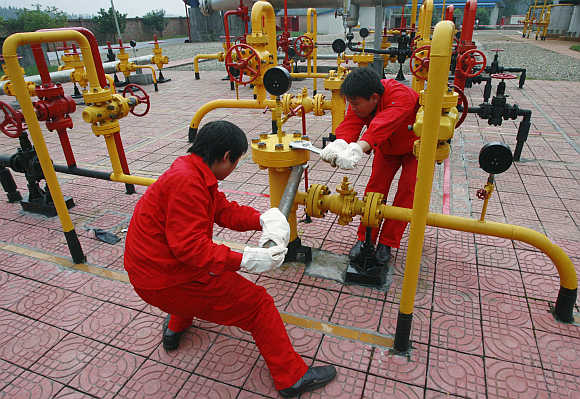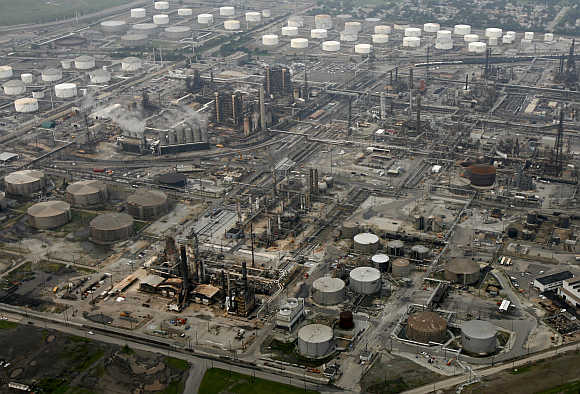Photographs: David Loh/Reuters
Villager are treating the project as a “golden goose” and are demanding huge compensation for their land.
In a demonstration of what the proposed Rs 37,230-crore (Rs 372.3 billion) refinery by Hindustan Petroleum Corporation Ltd means for Barmer, last week hundreds of people from the Pachpadra village in the district surprised Rajasthan Chief Minister Ashok Gehlot with a request to shift the refinery-cum-petrochemical complex to their village. The villagers were willing to give up their land for whatever price the government was offering after they heard that HPCL was facing problems in land acquisition.
Many hopes are riding on HPCL’s project in Barmer. However, it is not the first time that a refinery has been planned for the region. In 2009, state-run Oil and Natural Gas Corporation had also proposed to set up a refinery in Barmer, but it shelved the plan later citing viability concerns. Will HPCL be able to pull it off?
Barmer rose to prominence in January 2004 after Cairn Energy struck oil in the Mangala field - the largest onshore oil discovery in India in more than 20 years. The idea of a refinery close to the wells that produced 175,000 barrels of crude every day was first suggested by Subir Raha, the then chairman and managing director of ONGC.
ONGC holds 30 per cent participating interest in the RJ-ON-90/1 block in Barmer, while Cairn India holds the remaining 70 per cent.
...
Will it be second time lucky for Barmer?
Image: A worker checks a pipeline in the Balongan refinery belonging to Indonesia's state oil firm Pertamina in Indramayu, in West Java province. Photo is for representation purpose only.Photographs: Dadang Tri/Reuters
However, the production potential of the block at Barmer was not lucrative at that time to go ahead with the project. “At that time, the production profile of the Barmer block was not that high. For this kind of a refinery in the hinterland, you need an assured supply of crude oil for at least five to seven years, which was not there.
“Moreover, the state government was not ready to extend any fiscal incentive like exemption from sales tax, interest free loan, free land and power,” says R S Sharma, former chairman and managing director of ONGC.
The initial study conducted by SBI Caps, too, had suggested incentives from the state for the refinery. According to ONGC, without state sops, the rate of return on capital was going to be very poor - slightly above 1 per cent.
However, the state government was in no mood to extend those incentives to ONGC as it would have meant an additional expenditure of Rs 40,000 crore (Rs 400 billion).
“It was not realistic for a board-managed company to go ahead with such a project. For a hinterland project to sustain with only imported crude was not possible at all,” says Sharma.
ONGC finally decided to can the project in 2009. However, things began to change soon after that.
...
Will it be second time lucky for Barmer?
Image: Labourers work at a PetroChina refinery in Suining, southwest China's Sichuan province. Photo is for representation purpose only.Photographs: Stringer/Reuters
The biggest game changer was the rise in the production potential of RJ-ON-90/1 fields. The Rajasthan block now produces more than 20 per cent of the country’s total crude oil. “When it started in 2009, we were producing only 25,000 barrels of crude oil a day. Now it has increased to 175,000 barrels per day and it is expected to rise to around 215,000 barrels per day by the end of 2013-14,” says an industry expert.
So far, Cairn India has discovered 26 blocks in Mangala. The number is only set to increase with the company looking to invest another $2 billion in the Rajasthan block on exploration in the next two years.
The change of guard at the state government has also worked in favour of the project. The Gehlot-led Congress government is keen to bring investments into the state. “We anticipate over Rs 60,000-70,000 crore (Rs 600-700 billion) investment in the entire area once the refinery comes up,” a senior government official says.
In line with the suggestions made by the S C Tripathi Panel, which was set up in 2009 to evaluate the overall potential for the petroleum sector in Rajasthan, the state government has taken a 26 per cent stake in the refinery.
...
Will it be second time lucky for Barmer?
Image: British Petroleum oil refinery as seen in Whiting, Indiana, United States. Photo is for representation purpose only.Photographs: John Gress/Reuters
In addition, it has also decided to subsidise the refinery’s crude oil costs by $1 per barrel and give discounts to oil marketing companies for purchasing oil from the refinery. Once on stream, 50 per cent of the crude oil for the refinery will come from Barmer and the rest will be imported.
“What attracted us towards the project was the state government’s willingness to take a 26 per cent stake and its offer to give an interest-free loan for 15 years,” says K Murli, director (refineries), HPCL. The state government has agreed to offer interest-free loan from 2016-17 to 2030-31, which can be repayed in annual installments from 2031-32.
The company is expecting to achieve financial closure on the project in the next two months. A clearance from the Cabinet Committee on Economic Affairs is also expected by then, says Murli.
Meanwhile, Engineers India has also submitted a proposal before the state government to take 5 per cent equity in the project. However, the refinery is likely to cast a cloud over Cairn India’s continuously heated and insulated crude oil pipeline. It would render the pipeline that transports crude oil from Barmer to refineries elsewhere useless unless it is used by HPCL to pump out finished products from the refinery.
...
Will it be second time lucky for Barmer?
Image: Oil worker Denis Pena conducts operations at the Main Production Platform Urdaneta in the middle of Lake Maracaibo, about 65km from Maracaibo City, in Venezuela. Photo is for representation purpose only.Photographs: Jorge Silva/Reuters
According to a state government official, the more likely option before Cairn India is to use the pipeline to bring in imported crude oil for the refinery. Some concerns remain for HPCL too. Locals are treating the project as a “golden goose” and are demanding a huge compensation for their land. They also want jobs.
“We would not let the government to acquire the land forcefully. The government will have to give us proper compensation and jobs,” says Meghchand Chowdhury, a local resident of Leelala, the site for the project.
When the project was announced, the land was priced at around Rs 20,000 per bigha but now the farmers are demanding Rs 40 to 60 lakh per bigha. “We were facing some land-related issues. Now, the government has come out with an alternative location nearby. We are looking into the suggestion," says K V Rao, director (finance), HPCL.
According to the state government, shifting the refinery to Pachpadra would add to the cost. “The new location that they are suggesting is mostly uninhabited. Those who are doubtful about the success of a hinterland refinery should look into the West Asian countries. It is not impossible and we expect the production from Barmer block to increase,” says Murli.







article